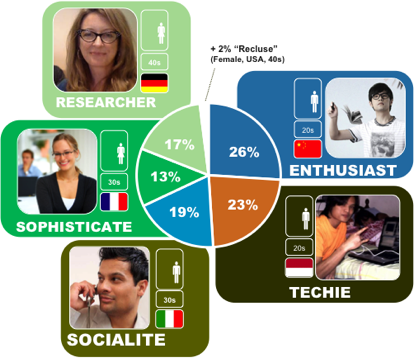This post is meant for the newbie entrepreneur, or the newly initiated marketer.
 I have been taking a number of “business” related modules this winter, and I have been put through a quite few hours of lecturing which focus on the “search”. Do you know your customer? Do your understand your customer?
I have been taking a number of “business” related modules this winter, and I have been put through a quite few hours of lecturing which focus on the “search”. Do you know your customer? Do your understand your customer?
When it comes to Marketing, yes we all know that STP is important. That’s short for Segmenting, Targeting and Positioning. And so are the 4Ps – Product, Price, Place, and Promotion.
But what do you do when your business is an e-business? Where everybody and anybody can access your website? How does STP come into play here? And the 4Ps?
Well that got me interested in the concept of Customer Archetypes. This supposedly helps to provide some direction for the newbie entrepreneur, or the newly initiated marketer.
So I embarked on a search. An Internet search, because well, the Internet is just so convenient. In fact, it’s so convenient that I feel all business today ought to have an e-presence. If you ain’t have one, you’re not good. Or so the lazy, instant-gratification driven customer like me thinks.
Top of my search was an article by CustomerSense. I liked the article because it was short and easy to understand.
According to CustomerSense, customer archetypes convert data into customer behavior, which I totally agree. Data is meaningless until we can make sense out of it. What good is a piles and piles of folders containing a hell lot of data about your customers? You’ll just be paralyzed by the stacks of interviews, user tests, focus groups, surveys, site statistics, support call tracking and much more…
CustomerSense proposed that the best way forward is not about writing good, well-document reports that clearly outlines findings about your customers. Rather, it is to define images and understandings of who your customers are; what they need of you and how they behave when interacting with your site and company. Well said! A picture speaks a thousand words, if you are able to hash together from your data set, distinct needs and behaviors into a few customer “stereotypes”, you are now able to re-jig your marketing efforts towards these customers in a more targeted manner. And in marketing speak, the more targeted you are, the better the return on investment (ROI).
Of course, pulling out clear trends and needs from customer data is no mean feat. And in the many things that we juggle, there is a very strong tendency for you and I to attempt a one-size-fits-all approach. “When trying to design for everybody, you end up designing for nobody.” Wise words from CustomerSense. Any marketer worth his or her salt will scoff at the one-size-fits-all approach. Why bother with STP then? From a customer’s point of view, any commercial that seems to resonate with my needs is sure to catch my attention. Take for instance Coca-Cola – notice how their advertisements are full of lifestyle and happiness. Check out some of their top advertising videos here. And these definitely DO work. Look at their EBT Margins (Earnings Before Tax), the lowest in the past 10 years is an astonishing 23%!! If I’m not mistaken, a good 20% of their revenue gets ploughed back into their marketing efforts each year.
And thus, CustomerSense says that when we describe these (hypothetical) customers in detail, their name and age, were they live, their educational level, if they are married or divorced, their preferences towards buying your products and services, how skilled they are in using a computer, their aspirations, etc, we will able to focus our development process on the exact goals and needs of our customers. I couldn’t agree more on this. Back to my Coca-Cola example above if you wanted more elaboration.
Finally, CustomerSense wraps up by saying customer archetypes create a shared organizational focus. In my humble opinion, I that this is THE MOST important value of customer archetypes. The process of sifting through the customer data, identifying the commonalities, and building the various customer archetypes together with your team, I believe that this is probably the best way for all team members of the business to work together and move ahead together. Nothing like a good and honest bashing of each other’s idea to fine-tune them.
Not to mention the team bonds that will develop as a result. As the Chinese idiom goes, “you don’t know someone until you cross swords with them”.
Till next time!
